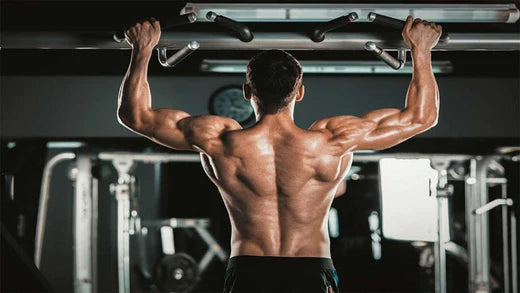Think back to when you began exercising. What was your first workout like? Chances are that you were introduced to the basics, the long-admired classics of muscle building. On the day you were set to target your back, the pull-up was probably the front-and-center exercise. Sound familiar?
Despite the yearly advancements in exercise technology and methodology theory, certain exercises have been used for decades and continue to dominate the fitness landscape. Why is it that the pull-up is still one of the most popular exercises for beginners to master and experienced lifters never to forget?
Let’s take a look at which muscles are activated by the pull-up, the benefits that come along with the exercise, and most importantly, how to do pull-ups if you want to see leaps and bounds in size and leanness.
MUSCLES ACTIVATED DURING A PULL-UP
The first reason that you often see the pull-up featured on most back workouts is that it is a compound exercise, which means it targets several major muscle groups along with many secondary or smaller muscles. Here’s a breakdown of the list of muscles that are activated during a pull-up:
PRIMARY MOVERS
The term “primary movers” is another way to say the muscles that are most involved during an exercise. Not surprisingly, the prime movers for the pull-up focus on the entirety of the back.
- Latissimus Dorsi: This muscle group is the main point of focus during a pull-up. When you are sore the next day after a gruelling workout of pull-ups, this will be where you feel it most. Often abbreviated as the lats, this muscle can be found in the middle of the back where your rib cage wraps around. If you want to have that spread out or winged muscular look where your back expands giving you a wider appearance, targeting the lats is the way to go.
- Middle and Lower Trapezius: A long muscle that runs from the base of your neck, down your shoulder, and to the middle of your back. It helps to move your scapula and supports the full range of motion in your arms. The middle traps are often neglected during back workouts in favour of the upper traps with exercises like shrugs. Targeting the full range of trapezoids will help to give your back a well-rounded muscular look.
- Rhomboids: This muscle begins at your spine where the base of your shoulder sits and it moves across to your shoulder blade. Like the trapezius, it supports the scapula and full range of motion for your arms.
- Deltoids: Look at the point where your arm connects to your shoulder. This is your deltoid. There are three heads to the deltoid muscle: front, lateral, and rear. All three are activated during a pull-up. The rear deltoid is directly involved in the lifting and lowering of the body while the lateral and front heads are used for stability and control.
- Infraspinatus: This muscle covers the shoulder blade and plays a pivotal role in the full range of motion in the shoulder joint.
- Teres Major: This small muscle sits just beneath the infraspinatus and assists with the extension of the lats.
- Subscapularis: A triangular-shaped muscle that gives a helping hand to the deltoids, infraspinatus, and teres major during a pull-up by drawing the arm bone down and forward.
SECONDARY MUSCLE GROUPS
While not as directly involved as the primary movers, these secondary muscle groups still help to play a critical role in the proper execution of a pull-up. As you’ll see, most of the muscles involved help to keep the body straight and controlled while performing the exercise.
- Erector Spinae: This is a long strip of muscle that runs along the spine. It’s responsible for supporting the back so you can sit up straight, and turn from side to side.
- Biceps Brachii: Whenever you have an arms day and you’re performing a curl, this is the primary muscle you’re targeting. Beginners tend to have sore biceps following a pull-up-based workout because the biceps play a role in the lifting and lowering of the body. The closer your grip, the more you’ll feel it in your biceps. To get the most out of a pull-up for your back, not your biceps, use a wide grip.
- Brachialis: The deeper muscle beneath your biceps brachii, the brachialis supports healthy flexion at the elbow joint, a necessity during the pull-up.
- Forearms: The muscles and connective tissues that the pull-up targets include the brachioradialis, flexor carpi radialis, flexor carpi ulnaris, flexor digitorum profundus, flexor digitorum superficialis, flexor pollicis longus, and palmaris longus. The forearms act as a point of stabilization and support the wrist during the pull-up. For those with prior wrist issues, wrist wraps can help to alleviate soreness.
- Pectoralis Major and Minor: The technical name for your chest muscles, the pecs help to support the body and promote controlled lifting and lowering. Although your pets are involved as a method of balance and support, you don’t have to worry about your chest being sore after pull-ups. Want to increase your bench press while you perfect your pull-up? Check out our article on how to increase your bench press.
- External Oblique: This muscle is found on your rib cage and it makes up an important part of the core musculature. During a pull-up, the obliques help to stabilize the body from twisting and turning during the lifting and lowering.
BENEFITS OF PULL-UPS
The list above is extensive, but it’s important to see how many muscles are involved in a pull-up to drive home the point that it is and always will be an essential part of an upper-body workout. Aside from activating many muscle groups simultaneously, the pull-up has a few other great benefits:
Muscle Mass: Mastering one’s own body weight can lead to significant gains in lean muscle mass. Sure, weightlifting is important, but the ability to execute dozens of perfect pull-ups is a testament to the mind-to-muscle connection during elite-level muscle building. If you’re a beginner, before you start loading up a barbell for rows, focus on how to do pull-ups first.
- Recovery is an essential part of muscle building. As you probably already know, protein is key to muscle recovery and growth. If you want to build a bigger back, don’t make these protein mistakes.
Fat Burning: Since it targets several primary and secondary muscle groups, the pull-up is one hell of a calorie-burning exercise. If you’re focused on weight loss – not intense muscle building – the pull-up can help. It will increase caloric expenditure while promoting lean muscle development. The more lean muscle you have, the more calories your body burns at rest, supporting long-term weight management.
Another great way to increase weight loss is with a waist trimmer belt. Learn how to use it to spot and reduce fat.
Strength: The pull-ups are excellent at supporting two types of strength: upper body strength and grip strength. Overall upper body strength is important as it can help or hurt other exercises such as the chest press, shoulder press, and row. Getting stronger via pull-ups will help you see improvements in other exercises.
The other form of strength that the pull-up can increase is grip strength. If your grip is failing long before the working muscle, you’re cheating yourself out of results. Improving your grip strength can help to increase repetitions performed, and muscle endurance, and reduce the risk of wrist, forearm, and elbow injury.
HOW TO DO A PULL-UP
You know exactly which muscles to focus on as you move through a pull-up, and you’re aware of how this exercise can benefit you in the long term, now let’s get to the most important part: how to do a pull-up.
- Reach up and take hold of a pull-up bar or a surface that you can comfortably and safely hold on to for an extended period of time.
- Check your grip: Make sure your hands are outside of shoulder width. As we mentioned above, the wider the grip, the less the biceps are involved.
- Before you lift your feet from the floor, check in with your body. Form a mind-to-muscle connection with the back. Contract the muscles that are going to be pulling you up.
- Lift your feet and bend your knees. You’ll be in a hanging position with the core engaged, back contracted, and elbows slightly bent.
- Focusing the movement in your back, pull yourself up towards the bar. Your arms are just anchors here; they should not be doing the work. Let your back pull you up.
- Once your chest nears the bar, pause and squeeze your grip and back muscles.
- Slowly, lower yourself to the starting position. Do not let yourself drop down. Control every second of the exercise.
A quick tip: If you want to dramatically increase your grip strength, use Alpha Grips on the pull-up bar.
DID THIS HELP YOU UNDERSTAND HOW TO DO PULL-UPS?
Did you need to tweak your form after reading this post? Will you start incorporating more pull-ups into your back workouts? Have a before and after picture of your back after a month or two of pull-ups? Tag us on Instagram so we can share it!






